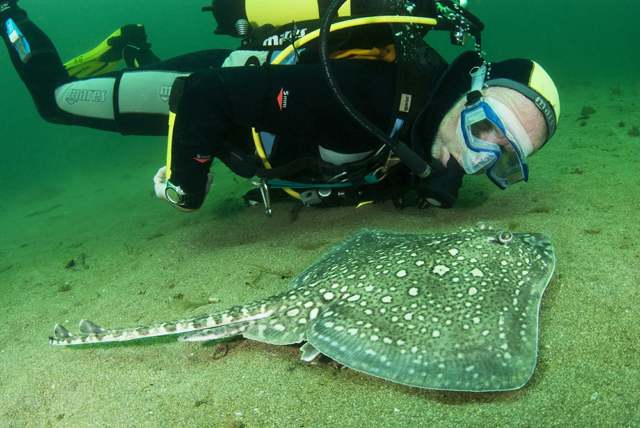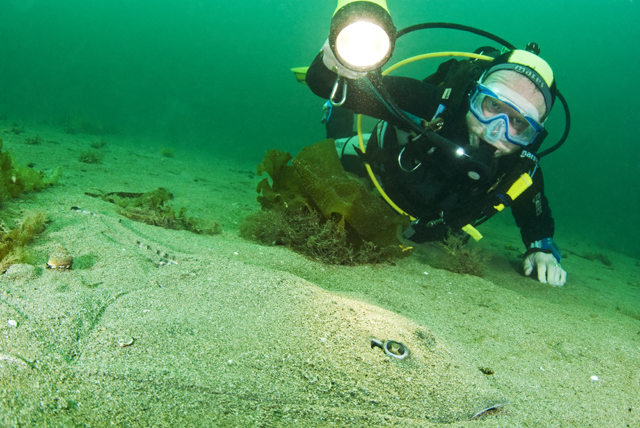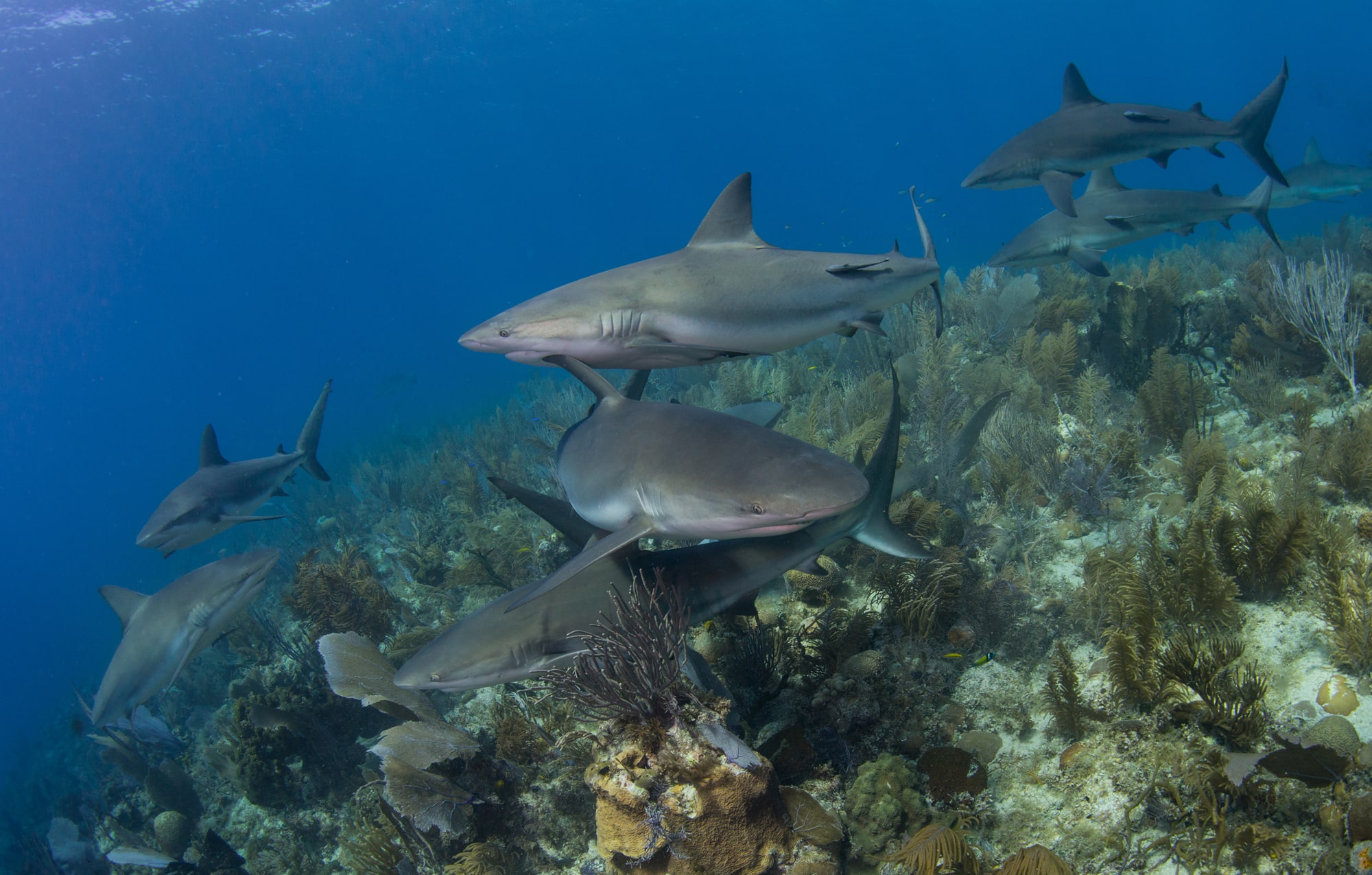Marine Life & Conservation
Have A Ray Day
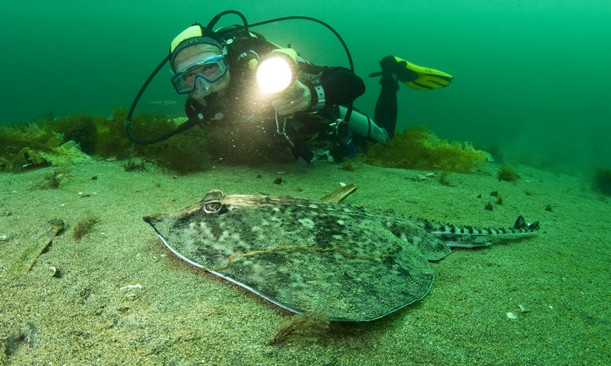
Mike Anselmi, the owner of Porthkerris Dive Centre in Cornwall, said that the Helford River Estuary is one of the most popular dive sites in the area. The shallow seabed attracts all sorts of interesting marine life including Sea Hares, Cuttlefish, Clams, Scallops, Hermits and Blonde Rays. May through to August is peak season for Thornback Ray (Raja clavata) sightings. Mike said that the Rays congregated in larger numbers around mid-August. During this time it’s not unusual to see at least 5 or 6 different individuals on a single 1 hour long dive. The Rays stick together in loose packs, so when one is sighted there are usually others somewhere close by.
This is a unique underwater experience and gives divers and photographers the perfect opportunity to get up close and personal with these creatures. It’s even possible to swim side by side as they effortlessly ‘fly’ across the seabed. Thornbacks shouldn’t be confused with their close relatives, Sting Rays. They are totally non-aggressive and pose no threat to divers. There are no lethal looking barbs protruding from the tail. Instead they have 30-50 spines along the tail and up the back which could potentially give someone a graze but only if the Ray is grabbed or picked up. The mouth is located on the white coloured underside. This has rows of very small teeth which make perfect tools for crunching on Crabs, Prawns and Flatfish – not divers.
The Charter Boat
Mike has been running the family business for more than 22 years. He owns 2 hard boats and a twin engined RIB. We went out on Mike’s flagship, the 14 metre long Celtic Cat. Getting onto the boat is quite a novel experience. There is no jetty, so divers have to walk along a high rise gangplank which is then pushed into the sea by a Tractor. Mike’s other hard boat, the smaller 8 metre long Celtic Kitten, has a bow ramp so it can come right up to the beach. Celtic Cat has plenty of room onboard for kitting up and gear stowage. The boat also has a big enclosed cabin area and an inner sanctum where I could get hot drinks. Mike has fitted a double diver lift on the stern which is controlled by CCTV linked to the high rise Bridge. Mike normally offers the Thornback Ray dive as and when he’s asked. He said that the Rays come closer inshore during calm weather; they don’t like choppy seas.
Arrival at the site
Porthkerris Dive Centre is located way down on the South West Coast of Cornwall near the Lizard. RNAS Culdrose is a good landmark to aim for and then follow the signs to St Keverne. The last few miles can be quite confusing (I took the wrong turning, duh!) but there’s still a mobile signal for any ‘help, I’m lost’ SOS calls to the dive centre. When I started seeing the Basking Shark (this is the other big attraction) signs I knew I was on the right track. The narrow hedge-lined lanes eventually open out onto a very picturesque little bay. The new dive centre building is located right next to the pebble beach. On-site facilities include a dive shop, 2 camp sites, toilets, cafe, car park, gas fills and plenty of shore diving possibilities. There are even a number of Pubs close by. The local Seal sanctuary located at Gweek is also worth a visit during off gassing periods.
Pre-dive briefing
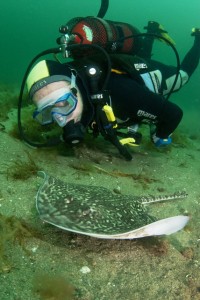
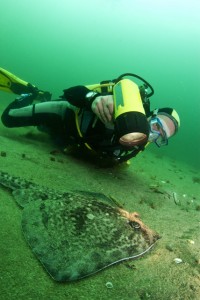 The Helford River is about 20 minute’s boat ride from Porthkerris Dive Centre. At high water it’s around 12 metres deep at the river mouth and 8 metres further up the estuary by the boat moorings. The seabed is made up of sand and shingle in the central channel. Nearer the edges and further up the estuary this changes to a maerl-like composition interspersed with patches of weed (perfect for Scallops).
The Helford River is about 20 minute’s boat ride from Porthkerris Dive Centre. At high water it’s around 12 metres deep at the river mouth and 8 metres further up the estuary by the boat moorings. The seabed is made up of sand and shingle in the central channel. Nearer the edges and further up the estuary this changes to a maerl-like composition interspersed with patches of weed (perfect for Scallops).
There can be strong currents, so it’s best to dive a few hours before high water on the flood tide when things are calming down. The visibility will be better and there is more chance of seeing Thornback Rays. Keep a close eye on air supplies, as chasing after Rays can be quite a tank-draining exercise. All divers should carry a delayed SMB. Mike asks that they are deployed at the end of the dive before commencing any safety stops. This is a busy waterway so be extra vigilant on ascents. Propeller haircuts are not advisable.
Mike dropped us in the middle of the channel right by the River mouth. The tide was still flooding which meant that the current would take us inside the channel rather than out to sea. We would also have ‘cleaner’ water for my photographs. We made a free descent without reference to the seabed. The Rays are not in any particular area so there is no set direction to take, it’s basically pot luck. We drifted along with the current scanning the seabed for any Ray like shapes.
The Dive
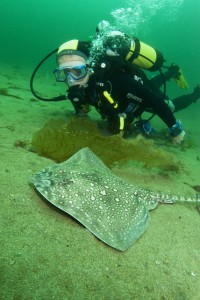 Creeping up on Thornback Rays turned out to be easier than I expected. I had brought along Brian Hayes, a diving friend of many years, to act as ‘model’ and Ray spotter. We found our first Ray in the first 2-3 minutes of our dive. I could make out the diamond shaped outline hidden under the sand. A pair of eye stalks and a sharp pointy nose were the only parts visible. I guess this was in readiness to strike at any prey that unwittingly wandered into the kill zone.
Creeping up on Thornback Rays turned out to be easier than I expected. I had brought along Brian Hayes, a diving friend of many years, to act as ‘model’ and Ray spotter. We found our first Ray in the first 2-3 minutes of our dive. I could make out the diamond shaped outline hidden under the sand. A pair of eye stalks and a sharp pointy nose were the only parts visible. I guess this was in readiness to strike at any prey that unwittingly wandered into the kill zone.
Working as a team we managed to get within touching distance of around 5 or 6 different Rays on each dive. The Rays seemed to react differently depending on the tide conditions. While the tide was still flooding they were more active and on the move. Mike thinks this is when they are feeding. On 3 occasions we had to swim like lunatics just to keep up. When there was very little tide we found 2 or 3 different Rays buried in the sand and they were very easy to approach – in fact, I could have touched them with my camera dome and they still wouldn’t have budged. I even got Brian to do a ‘Steve Irwin’ manoeuvre over the top of a Ray for a close-up head shot and there was still no reaction. Maybe the Ray thought that its camouflage was so good we couldn’t see it.
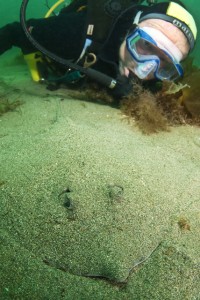 As the tide turned there seemed to be less Rays about and they were moving much more slowly. We had also moved up the estuary nearer to the boat moorings. The seabed composition had changed and there were far more Sea Hares around. We swam along with one particular Ray for a good 5 minutes and then bumped into a very photogenic Cuttlefish. None of the Rays shot off in an erratic manner or seemed distressed by our presence. Considering they were being sandwiched by 2 divers this was quite surprising.
As the tide turned there seemed to be less Rays about and they were moving much more slowly. We had also moved up the estuary nearer to the boat moorings. The seabed composition had changed and there were far more Sea Hares around. We swam along with one particular Ray for a good 5 minutes and then bumped into a very photogenic Cuttlefish. None of the Rays shot off in an erratic manner or seemed distressed by our presence. Considering they were being sandwiched by 2 divers this was quite surprising.
The Thornbacks we encountered varied in size from small 20cm wingspans to much bigger 50cm plus specimens. The colour schemes were usually grey or brown with a kaleidoscope pattern of spots and splodges on the topside. Most had 2 claspers dangling from the tail area meaning they were males. We only encountered one small female. Average recorded sizes are around 60 cm and weigh in at 3 or 4kg’s. They can grow to more than a metre in length and weigh over 15kg’s.
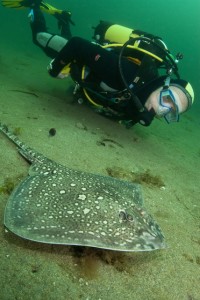 This has to be one of the best marine life dives in the UK and it’s at a shallow depth where every level of diver can safely join in the fun. Our close encounters were totally natural. There was no provocation or feeding enticements going on in the background. They say a picture paints a thousand words so hopefully my photographs show just how close we managed to get. With rather more luck than judgement we had chosen a perfect day for weather. There was plenty of sunlight and very little wave action to worry about. Underwater visibility was around 8 metres throughout and the current took away any kicked up silt during our power finning spurts. For once I actually had to admit this was pretty good going for UK conditions. The toughest part of the day was keeping my model focused on the job in-hand. Brian was getting more and more distracted by the number of decent sized Scallops scattered over the seabed. He even had his goody bag at the ready!
This has to be one of the best marine life dives in the UK and it’s at a shallow depth where every level of diver can safely join in the fun. Our close encounters were totally natural. There was no provocation or feeding enticements going on in the background. They say a picture paints a thousand words so hopefully my photographs show just how close we managed to get. With rather more luck than judgement we had chosen a perfect day for weather. There was plenty of sunlight and very little wave action to worry about. Underwater visibility was around 8 metres throughout and the current took away any kicked up silt during our power finning spurts. For once I actually had to admit this was pretty good going for UK conditions. The toughest part of the day was keeping my model focused on the job in-hand. Brian was getting more and more distracted by the number of decent sized Scallops scattered over the seabed. He even had his goody bag at the ready!
Marine Life & Conservation
Double Bubble for Basking Sharks

 The Shark Trust is excited to announce that, for two more days only, all donations, large or small, will be doubled in the Big Give Green Match Fund!
The Shark Trust is excited to announce that, for two more days only, all donations, large or small, will be doubled in the Big Give Green Match Fund!
Donate to Basking in Nature: Sighting Giants
The Shark Trust is hoping to raise £10k which will be doubled to £20k. This will go towards Basking in Nature: Sighting Giants. And they need YOUR help to reach they’re goal.
The Shark Trust’s citizen science project is to monitor and assess basking sharks through sightings; encouraging data collection, community engagement, and promoting nature accessibility. This initiative aims to enhance health and wellbeing by fostering a deeper connection with British Sharks.
Campaign Aims
- Increase citizen science reporting of Basking Sharks and other shark sightings to help inform shark and ray conservation.
- Provide educational talks about the diverse range of sharks and rays in British waters and accessible identification guides!
- Create engaging and fun information panels on how to ID the amazing sharks and rays we have on our doorstep! These can be used on coastal paths around the Southwest. With activities and information on how you can make a difference for sharks and rays!
- Promote mental wellbeing through increasing time in nature and discovering the wonders beneath the waves!
Donate, and double your impact. Click Here
Marine Life & Conservation
Leading UK-based shark conservation charity, the Shark Trust, is delighted to announce tour operator Diverse Travel as a Corporate Patron
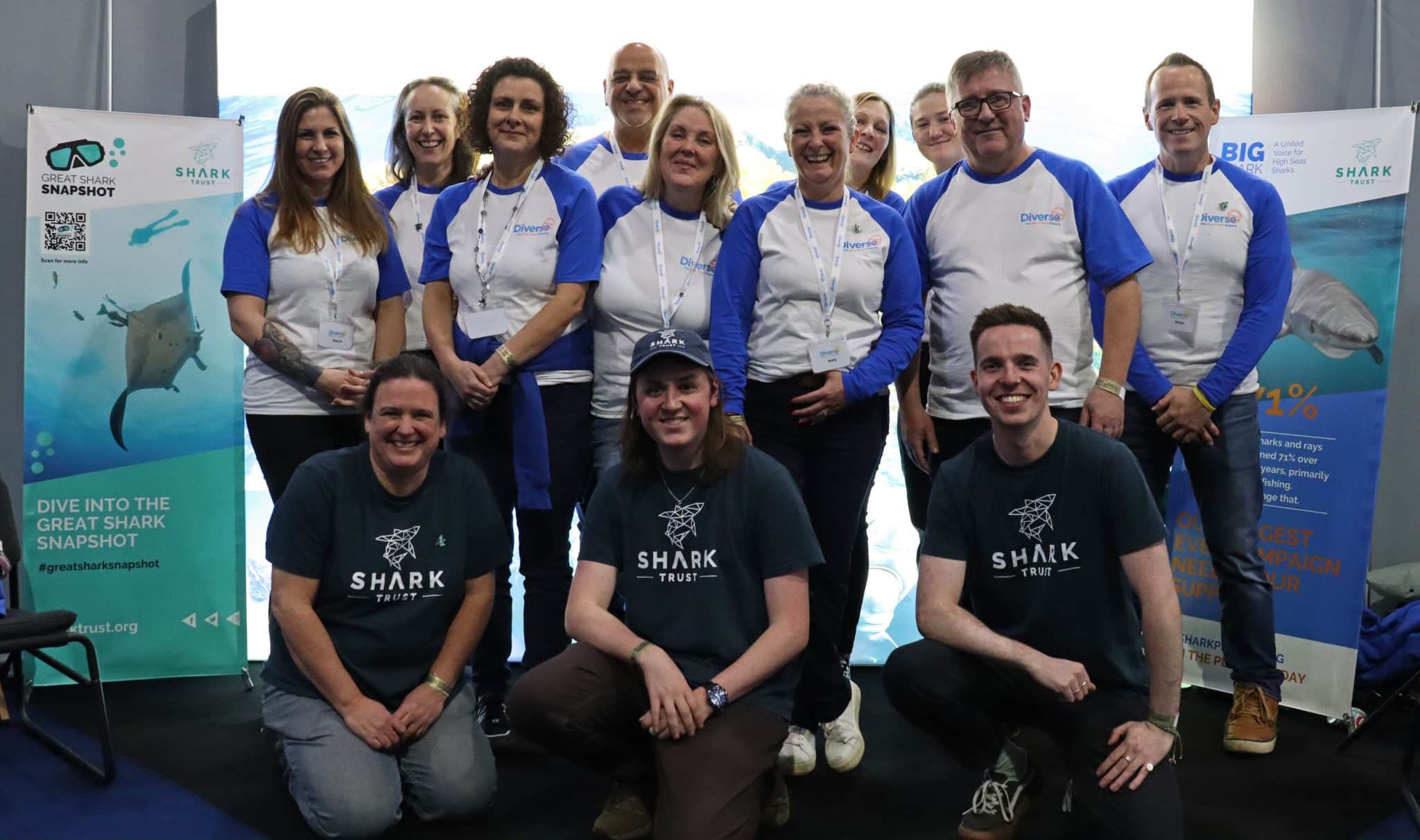
 Corporate Patrons provide a valuable boost to the work of The Shark Trust. The Trust team works globally to safeguard the future of sharks, and their close cousins, the skates and rays, engaging with a global network of scientists, policymakers, conservation professionals, businesses and supporters to further shark conservation.
Corporate Patrons provide a valuable boost to the work of The Shark Trust. The Trust team works globally to safeguard the future of sharks, and their close cousins, the skates and rays, engaging with a global network of scientists, policymakers, conservation professionals, businesses and supporters to further shark conservation.
Specialist tour operator Diverse Travel has operated since 2014 and is committed to offering its guests high quality, sustainable scuba diving holidays worldwide. Working together with the Shark Trust will enable both organisations to widen engagement and encourage divers and snorkellers to actively get involved in shark conservation.
“Sharks are truly at the heart of every diver and at Diverse Travel, we absolutely share that passion. There is nothing like seeing a shark in the wild – it’s a moment that stays with you forever!” says Holly Bredin, Sales & Marketing Manager, Diverse Travel.
“We’re delighted to celebrate our 10th year of business by becoming a Corporate Patron of the Shark Trust. This is an exciting partnership for Diverse and our guests. We will be donating on behalf of every person who books a holiday with us to contribute towards their vital shark conservation initiatives around the world. We will also be working together with the Trust to inspire divers, snorkellers and other travellers to take an active role – at home and abroad – in citizen science projects and other activities.”
Paul Cox, CEO of The Shark Trust, said:
“It’s an exciting partnership and we’re thrilled to be working with Diverse Travel to enable more divers and travellers to get involved with sharks and shark conservation. Sharks face considerable conservation challenges but, through collaboration and collective action, we can secure a brighter future for sharks and their ocean home. This new partnership takes us one more valuable step towards that goal.”
For more information about the Shark Trust visit their website here.
For more about Diverse Travel click here.
-

 News3 months ago
News3 months agoHone your underwater photography skills with Alphamarine Photography at Red Sea Diving Safari in March
-

 News3 months ago
News3 months agoCapturing Critters in Lembeh Underwater Photography Workshop 2024: Event Roundup
-

 Marine Life & Conservation Blogs3 months ago
Marine Life & Conservation Blogs3 months agoCreature Feature: Swell Sharks
-

 Blogs2 months ago
Blogs2 months agoMurex Resorts: Passport to Paradise!
-

 Blogs2 months ago
Blogs2 months agoDiver Discovering Whale Skeletons Beneath Ice Judged World’s Best Underwater Photograph
-

 Gear Reviews2 weeks ago
Gear Reviews2 weeks agoGEAR REVIEW – Revolutionising Diving Comfort: The Sharkskin T2 Chillproof Suit
-

 Gear Reviews3 months ago
Gear Reviews3 months agoGear Review: Oceanic+ Dive Housing for iPhone
-

 Marine Life & Conservation2 months ago
Marine Life & Conservation2 months agoSave the Manatee Club launches brand new webcams at Silver Springs State Park, Florida


